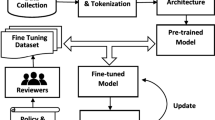Abstract
Development of a robust two-way real-time speech translationsystem exposes researchers and system developers to various challenges of machine translation(MT) and spoken language dialogues. The need for communicating in at least two differentlanguages poses problems not present for a monolingual spoken language dialogue system,where no MT engine is embedded within the process flow. Integration of various componentmodules for real-time operation poses challenges not present for text translation. In this paper,we present the CCLINC (Common Coalition Language System at Lincoln Laboratory) English–Koreantwo-way speech translation system prototype trained on doctor–patient dialogues,which integrates various techniques to tackle the challenges of automatic real-time speechtranslation. Key features of the system include (i) language–independent meaning representation which preserves the hierarchicalpredicate–argument structure of an input utterance, providing a powerful mechanism for discourse understanding of utterances originating from different languages,word-sense disambiguation and generation of various word orders of many languages, (ii) adoptionof the DARPA Communicator architecture, a plug-and-play distributed system architecturewhich facilitates integration of component modules and system operation in real time, and (iii)automatic acquisition of grammar rules and lexicons for easy porting of the system to differentlanguages and domains. We describe these features in detail and present experimental results.
Similar content being viewed by others
References
Black, Alan, Paul Taylor, and Richard Caley: 1998, The Festival Speech Synthesis System: System Documentation. http://www.cstr.ed.ac.uk/projects/festival.html.
Brill, Eric and Philip Resnik: 1994, ‘A Rule-Based Approach to Prepositional Phrase Attachment Disambiguation’, in COLING 94: The 15th International Conference on Computational Linguistics, Kyoto, Japan, pp. 1198–1204.
Collins, Michael: 1997, ‘Three Generative, Lexicalized Models for Statistical Parsing’, 35th Annual Meeting of the Association for Computational Linguistics and 8th Conference of the European Chapter of the Association for Computational Linguistics, Madrid, Spain, pp. 16–23.
Coulehan, John L. and Marian R. Block: The Medical Interview: Mastering Skills for Clinical Practice, F.A. Davis Company, Philadelphia.
Glass, James, Joe Polifroni, and Stephanie Seneff: 1994, ‘Multilingual Language Generation across Multiple Domains’, in Proceedings of International Conference on Spoken Language Processing, Yokohama, Japan, pp. 983–986.
Grishman, Ralph, Catherine Macleod, and Adam Meyers: 1994, ‘Comlex Syntax: Building a Computational Lexicon’, in COLING 94: The 15th International Conference on Computational Linguistics), Kyoto, Japan, pp. 268–272.
Hale, Ken: 1982, ‘Preliminary Remarks on Configurationality’, in Proceedings of NELS 12, MIT, pp. 86–96.
Hutchins, W. J. and H. L. Somers: 1992, An Introduction to Machine Translation, Academic Press, London.
Jelinek, Frederick: 1997, Statistical Methods for Speech Recognition, The MIT Press, Cambridge, MA.
Lavie, Alon, Donna Gates, Noah Coccaro, and Lori Levin: 1996, ‘Input Segmentation of Spontaneous Speech in Janus: A Speech-to-Speech Translation System’, in 12th European Conference on Artficial Intelligence, Budapest, pp. 54–59.
Lavoie, Benoit, Michael White, and Tanya Korelsky: 2001, ‘Inducing Lexico-Structural Transfer Rules from Parsed Bi-Texts’, in Proceedings of ACL 2001 Workshop on Data-Driven Machine Translation, Toulouse, France, pp. 17–24.
Lee, Young-Suk: 2001, Interlingua-Based Open Domain Machine Translation: A Case Study from Korean-to-English Translation, MS-15178, MIT Lincoln Laboratory.
Lee, Young-Suk Lee: 1993, Scrambling as Case-Driven Obligatory Movement, Ph.D. Thesis (IRCS Report No.: 93–06), University of Pennsylvania.
Lee, Young-Suk, Clifford Weinstein, Stephanie Seneff, and Dinesh Tummala: 1997, ‘Ambiguity Resolution for Machine Translation of Telegraphic Messages’, 35th Annual Meeting of the Association for Computational Linguistics and 8th Conference of the European Chapter of the Association for Computational Linguistics, Madrid, Spain, pp. 120–127.
Lee, Young-Suk, Clifford Weinstein, Stephanie Seneff, and Dinesh Tumma: 1999, ‘Word Sense Disambiguation forMachine Translation in Limited Domains’, manuscript, Information Systems Technology Group, MIT Lincoln Laboratory, January.
Lee, Young-Suk, Wu Sok Yi, Stephanie Seneff, and Clifford Weinstein: 2001, ‘Interlingua-Based Broad-Coverage Korean-to-English Translation in CCLINC’, in Proceedings of Human Language Technology 2001 Conference, San Diego, CA.
Levin, Lori, Alon Lavie, Monika Woszczyna, Donna Gates, Marsal Gavaldà, Detlef Koll, and Alex Waibel: 2000, ‘The Janus-III Translation System: Speech-to-Speech Translation in Multiple Domains’, Machine Translation 15, 3–25.
Marcus, Marcus, Beatrice Santorini, and Mary Ann Arcinkiewicz: 1993, ‘Building a Large Annotated Corpus of English: The Penn Treebank’, Computational Linguistics 19, 313–330.
Papineni, Kishore, Salim Roukos, Todd Ward, and Wei-Jing Zhu: 2002, ‘Bleu: A Method for Automatic Evaluation of Machine Translation’, in 40th Annual Meeting of the Association for Computational Linguistics, Philadelphia, PA, pp. 311–318.
Park, Jun and Jae-Woo Yang: 1999, ‘ETRI Speech Translation System’, in Proceedings of CSTAR Workshop, Schwetzingen, Germany.
Seneff, Stephanie: 1992, ‘TINA: A Natural Language System for Spoken Language Applications’, Computational Linguistics 18, 61–92.
Seneff, Stephanie, Ed Hurley, Raymond Lau, Christine Pao, Philipp Schmid, and Victor Zue: 1998, ‘Galaxy-II: A Reference Architecture for Conversational System Development’, in Proceedings of ICSLP 98, Sydney, Australia.
Smith, Robert C.: 1996, The Patient's Story: Integrated Patient-Doctor Interviewing, Little, Brown, and Company, Boston.
Srinivas, Bangalore and Aravind K. Joshi: 1995, ‘Some Novel Applications of Explanation-Based Learning for Parsing Lexicalized Tree-Adjoining Grammars’, in 33rd Annual meeting of the Association for Computational Linguistics, Cambridge, MA, pp. 268–275.
Stolcke, Andreas: 2000, ‘Dialogue Act Modeling for Automatic Tagging and Recognition of Conversational Speech’, Computational Linguistics 26, 339–373.
Weinstein, Clifford, Young-Suk Lee, Stephanie Seneff, Dinesh Tummala, Beth Carlson, John T. Lynch, Jung-Taik Hwang, and Linda Kukolich: 1997, ‘Automated English-Korean Translation for Enhanced Coalition Communications’, The Lincoln Laboratory Journal 10, 35–60.
Young, Steve, Julian Odell, Dave Ollason, Valtcho Valtchev, and Phil Woodland: 1997, The HTK Book, Version 2.1, Cambridge University.
Author information
Authors and Affiliations
Rights and permissions
About this article
Cite this article
Lee, YS., Sinder, D.J. & Weinstein, C.J. Interlingua-based English–Korean Two-way Speech Translation of Doctor–Patient Dialogues with CCLINC. Machine Translation 17, 213–243 (2002). https://doi.org/10.1023/B:COAT.0000010801.30299.10
Issue Date:
DOI: https://doi.org/10.1023/B:COAT.0000010801.30299.10




